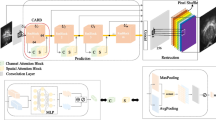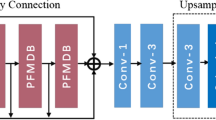Abstract
High-resolution medical images can help doctors to find early lesions and provide assistance and support for the diagnosis and treatment of diseases. Super-resolution can obtain a single high-resolution image from a given low-resolution image. It can be divided into three major means roughly: the interpolation-based methods, the reconstruction-based methods, and the learning-based methods. The interpolation-based methods rely on the smoothness assumptions and cannot restore fine textures. The reconstruction-based methods need to find the image degradation model and the optimal blur kernels. In fact, blur kernels are complicated and unknown. Kernel mismatch will fail to produce good results (e.g., over-sharpening or over-smoothing). The learning-based methods pay more attention to the understanding of the image content and structure, and they can establish a mapping function between the high-resolution images and the low-resolution images, which attract the attention of researchers. Deep learning has the strong ability of nonlinear mapping. Therefore, it has been widely used in super-resolution in recent years. In the paper, we propose a multi-scale deep residual channel attention network which consists of six components: joint input of low-resolution image and edge, shallow feature extraction, deep feature extraction, channel attention, high-resolution image reconstruction, and total loss. Edges are the first-order high-frequency details which are very important to super-resolution. The joint input of low-resolution images and edges enhances useful information. The multi-scale deep residual channel attention module can not only acquire structural features but also capture features of different scales and hierarchies. It can also obtain relationships among channel features. In addition, the joint guidance of perceptual loss, content loss, and edge loss is used to improve the visual quality and preserve the spatial structure and high-frequency details of low-resolution images. Experiments have been conducted on the pulmonary nodule image dataset, and the results demonstrate that the proposed method can yield better performance by comparing with the state-of-the-art methods.





Similar content being viewed by others
References
Choi J, Kim M (2017) Single image super-resolution using global regression based on multiple local linear mappings. IEEE Trans Image Process 26(3):1300–1314
Yang J, Wright J, Huang TS, Ma Y (2010) Image super-resolution via sparse representation. IEEE Trans Image Process 19(11):2861–2873
Yang J, Wang Z, Lin Z, Cohen S, Huang TS (2012) Coupled dictionary training for image super-resolution. IEEE Trans Image Process 21(8):3467–3478
Zhang Z, Jiang W, Li F, Zhao M, Li B, Zhang L (2017) Structured latent label consistent dictionary learning for salient machine faults representation-based robust classification. IEEE Trans Ind Inform 13(2):644–656
Zhang Z, Li F, Zhao M, Zhang L, Yan S (2017) Robust neighborhood preserving projection by nuclear/l2, 1-norm regularization for image feature extraction. IEEE Trans Image Process 26(4):1607–1622
Yuan X, Yuan X (2011) Fusion of multi-planar images for improved three-dimensional object reconstruction. Comput Med Imaging Gr 35(5):373–382
Efrat N, Glasner D, Apartsin A, Nadler B, Levin A (2013) Accurate blur models vs. image priors in single image super-resolution. In: IEEE International Conference on Computer Vision, ICCV 2013, Sydney, Australia, 1–8 Dec, pp 2832–2839
Yang C, Ma C, Yang M (2014) Single-image super-resolution: a benchmark. In: European Conference on Computer Vision, ECCV 2014, Zurich, Switzerland, 6–12 Sept, pp 372–386
Gu S, Sang N, Ma F (2012) Fast image super resolution via local regression. In: International Conference on Pattern Recognition, ICPR 2012, Tsukuba, Japan, 11–15 Nov, pp 3128–3131
Yang C, Yang M (2013) Fast direct super-resolution by simple functions. In: IEEE International Conference on Computer Vision, ICCV 2013, Sydney, Australia, 1–8 Dec 2013, pp 561–568
Romano Y, Isidoro J, Milanfar P (2017) RAISR: rapid and accurate image super resolution. IEEE Trans Comput Imaging 3(1):110–125
Gu S, Zuo W, Xie Q, Meng D, Feng X, Zhang L (2015) Convolutional sparse coding for image super-resolution. In: IEEE International Conference on Computer Vision, ICCV 2015, Santiago, Chile, 7–13 Dec 2015, pp 1823–1831
Chang H, Yeung D, Xiong Y (2004) Super-resolution through neighbor embedding. In: IEEE Conference on Computer Vision and Pattern Recognition, CVPR 2004, Washington, DC, USA, 27 June–2 July, pp 275–282
Timofte R, Smet VD, Gool LV (2013) Anchored neighborhood regression for fast example-based super-resolution. In: IEEE International Conference on Computer Vision, ICCV 2013, Sydney, Australia, 1–8 Dec, pp 1920–1927
Timofte R, Smet VD, Gool LV (2014) A+: adjusted anchored neighborhood regression for fast super-resolution. In: Asian Conference on Computer Vision, ACCV 2014, Singapore, 1–5 Nov, pp 111–126
Ledig C, Theis L, Huszar F, Caballero J, Cunningham A, Acosta A, Aitken AP, Tejani A, Totz J, Wang Z, Shi W (2017) Photo-realistic single image super-resolution using a generative adversarial network. In: IEEE Conference on Computer Vision and Pattern Recognition, CVPR 2017, Honolulu, HI, USA, 21–26 July 2017, pp 105–114
Johnson J, Alahi A, Fei-Fei L (2016) Perceptual losses for real-time style transfer and super-resolution. In: European Conference on Computer Vision, ECCV 2016, Amsterdam, The Netherlands, 11–14 Oct, pp 694–711
Dong C, Loy CC, He K, Tang X (2014) Learning a deep convolutional network for image super-resolution. In: European Conference on Computer Vision, ECCV 2014, Zurich, Switzerland, 6–12 Sept, pp 184–199
Liang Y, Wang J, Zhou S, Gong Y, Zheng N (2016) Incorporating image priors with deep convolutional neural networks for image super-resolution. Neurocomputing 194:340–347
Xie J, Feris RS, Sun M (2016) Edge-guided single depth image super resolution. IEEE Trans Image Process 25(1):428–438
Yang W, Feng J, Yang J, Zhao F, Liu J, Guo Z, Yan S (2017) Deep edge guided recurrent residual learning for image super-resolution. IEEE Trans Image Process 26(12):5895–5907
Liu H, Fu Z, Han J, Shao L, Hou S, Chu Y (2019) Single image super-resolution using multi-scale deep encoder–decoder with phase congruency edge map guidance. Inf Sci 473:44–58
Kim J, Lee JK, Lee KM (2016) Accurate image super-resolution using very deep convolutional networks. In: IEEE Conference on Computer Vision and Pattern Recognition, CVPR 2016, Las Vegas, NV, USA, 27–30 June, pp 1646–1654
Kim J, Lee JK, Lee KM (2016) Deeply-recursive convolutional network for image super-resolution. In: IEEE Conference on Computer Vision and Pattern Recognition, CVPR 2016, Las Vegas, NV, USA, 27–30 June, pp 1637–1645
Lai W, Huang J, Ahuja N, Yang M (2017) Deep Laplacian pyramid networks for fast and accurate super-resolution. In: IEEE Conference on Computer Vision and Pattern Recognition, CVPR 2017, Honolulu, HI, USA, 21–26 July, pp 5835–5843
Dong C, Loy CC, Tang X (2016) Accelerating the super-resolution convolutional neural network. In: European Conference on Computer Vision, ECCV 2016, Amsterdam, The Netherlands, 11–14 Oct, pp 391–407
Shi W, Caballero J, Huszar F, Totz J, Aitken AP, Bishop R, Rueckert D, Wang Z (2016) Real-time single image and video super-resolution using an efficient sub-pixel convolutional neural network. In: IEEE Conference on Computer Vision and Pattern Recognition, CVPR 2016, Las Vegas, NV, USA, 27–30 June, pp 1874–1883
Hu Y, Gao X, Li J, Huang Y, Wang H (2018) Single image super-resolution via cascaded multi-scale cross network. CoRR arXiv:abs/1802.08808
Li J, Fang F, Mei K, Zhang G (2018) Multi-scale residual network for image super-resolution. In: European Conference on Computer Vision, ECCV 2018, Munich, Germany, 8–14 Sept, pp 527–542
Huang G, Liu Z, van der Maaten L, Weinberger KQ (2017) Densely connected convolutional networks. In: IEEE Conference on Computer Vision and Pattern Recognition, CVPR 2017, Honolulu, HI, USA, 21–26 July, pp 2261–2269
Tong T, Li G, Liu X, Gao Q (2017) Image super-resolution using dense skip connections. In: IEEE International Conference on Computer Vision, ICCV 2017, Venice, Italy, 22–29 Oct, pp 4809–4817
Zhang Y, Tian Y, Kong Y, Zhong B, Fu Y (2018) Residual dense network for image super-resolution. In: IEEE Conference on Computer Vision and Pattern Recognition, CVPR 2018, Salt Lake City, UT, USA, 18–22 June, pp 2472–2481
Wang X, Yu K, Wu S, Gu J, Liu Y, Dong C, Qiao Y, Loy CC (2018) ESRGAN: enhanced super-resolution generative adversarial networks. In: European Conference on Computer Vision, ECCV 2018, Munich, Germany, 8–14 Sept, pp 63–79
Ahn N, Kang B, Sohn K (2018) Fast, accurate, and lightweight super-resolution with cascading residual network. In: European Conference on Computer Vision, ECCV 2018, Munich, Germany, 8–14 Sept, pp 256–272
Lim B, Son S, Kim H, Nah S, Lee KM (2017) Enhanced deep residual networks for single image super-resolution. In: IEEE Conference on Computer Vision and Pattern Recognition, CVPR 2017, Honolulu, HI, USA, 21–26 July, pp 1132–1140
Zhao H, Gallo O, Frosio I, Kautz J (2017) Loss functions for image restoration with neural networks. IEEE Trans Comput Imaging 3(1):47–57
Bruna J, Sprechmann P, LeCun Y (2016) Super-resolution with deep convolutional sufficient statistics. In: International Conference on Learning Representations, ICLR 2016, San Juan, Puerto Rico, 2–4 May
Simonyan K, Zisserman A (2015) Very deep convolutional networks for large-scale image recognition. In: International Conference on Learning Representations, ICLR 2015, San Diego, CA, USA, 7–9 May
Armato SGI, Mclennan G, Bidaut L, Mcnitt-Gray MF, Clarke LP (2011) The lung image database consortium (LIDC) and image database resource initiative (IDRI): a completed reference database of lung nodules on CT scans. Med Phys 38(2):915–931
Kingma DP, Ba J (2015) Adam: a method for stochastic optimization. In: International Conference on Learning Representations, ICLR 2015, San Diego, CA, USA, 7–9 May
He K, Zhang X, Ren S, Sun J (2015) Delving deep into rectifiers: surpassing human-level performance on imagenet classification. In: IEEE International Conference on Computer Vision, ICCV 2015, Santiago, Chile, 7–13 Dec, pp 1026–1034
Huynh-Thu Q, Ghanbari M (2008) Scope of validity of PSNR in image/video quality assessment. Electron Lett 44(13):800–801
Wang Z, Bovik AC, Sheikh HR, Simoncelli EP (2004) Image quality assessment: from error visibility to structural similarity. IEEE Trans Image Process 13(4):600–612
Acknowledgements
This work is supported in part by the Natural Science Foundation of China under Grant 61702157 and 41804118, in part by Hebei Province Department of Education Fund under Grant QN2018085, and in part by Innovation Capacity Improvement Project of Hebei Province 199676146H.
Author information
Authors and Affiliations
Corresponding author
Ethics declarations
Conflict of interest
The authors declare that they have no conflict of interest.
Additional information
Publisher's Note
Springer Nature remains neutral with regard to jurisdictional claims in published maps and institutional affiliations.
Rights and permissions
About this article
Cite this article
Qi, Y., Gu, J., Li, W. et al. Pulmonary nodule image super-resolution using multi-scale deep residual channel attention network with joint optimization. J Supercomput 76, 1005–1019 (2020). https://doi.org/10.1007/s11227-019-03066-3
Published:
Issue Date:
DOI: https://doi.org/10.1007/s11227-019-03066-3




